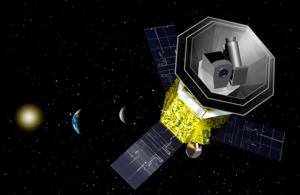LiteBIRD
Looking for evidence of gravitational waves in the Cosmic Microwave Background, to shed light on the first moments after the Big Bang. Launch is expected before 2030 and the mission will be 3 years long.

Artist’s interpretation of LiteBIRD taking measurements in space. The Sun, Earth and Moon can be seen in the background, showing LiteBIRD is positioned at Lagrangian point L2. Credit: ISAS/JAXA
Looking for traces of cosmological inflation
The Big Bang is a widely accepted theory of how our Universe began. However, what happened in the moments after is still not fully understood and could hold the answers to several problems in modern physics.
Cosmological inflation is a theory that explains the moments after the Big Bang. It asserts that the Universe expanded exponentially for a short time just after it formed, and explains observations made in cosmology. Cosmological inflation predicts primordial gravitational waves that will be observable in the Cosmic Microwave Background (CMB).
The CMB is remnant light from the early Universe, when it was hot plasma. It is mostly uniform, but contains slight variations that may give clues as to what happened just after the Big Bang. These variations correspond to gravitational waves imprinted on signals from ‘B-mode polarisation’ (the magnetic component of light) in the CMB. Observing different values for these variations will correspond to different cosmological inflation theories.

A section of a detailed representation of the distribution of CMB radiation density. Image credit: NASA / WMAP Science Team.
What is LiteBIRD and what will it do?
LiteBIRD is a Japanese Aerospace Exploration Agency (JAXA) mission aiming to find evidence for the theory of cosmological inflation. The spacecraft will be manufactured by the Institute of Space and Astronautical Science (ISAS) in Japan, will weigh about 450 kg and be launched with an H3 launch vehicle.
LiteBIRD aims to detect B-mode signals in the CMB to provide evidence for cosmological inflation. It will be sensitive enough to differentiate between variations in B-mode signals which will confirm the nature of how the Universe expanded just after the Big Bang.
To do this, LiteBIRD will undertake a 3-year full sky survey at the Sun-Earth Lagrangian point (L2). It will use three telescopes covering as many frequencies of light as possible; The Japanese delivered Low Frequency Telescope (LFT) and European delivered, jointly labelled Medium-High Frequency Telescopes (MHFT). LiteBIRD will implement around 4,500 transition edge sensors over 15 observational frequency bands.
Making use of state-of-the-art lenses and specialised frequency filters, LiteBIRD’s telescopes will be able to distinguish between the CMB and signals generated from dust and synchrotron radiation. It will be cryogenically cooled to around 100 mK to reduce thermal noise and use superconducting polarimeters to measure the polarisation of B-mode signals, with unprecedented sensitivity.
UK Space Agency support and UK involvement
The UK Space Agency has committed an initial £2.7 million to the LiteBIRD mission which will fund:
- a group of UK scientists to design LiteBIRD’s highly specialised telescope optical instruments
- production of the telescopes’ lenses and filters by Cardiff University, which is the only institution in the world with the expertise needed to make them
The UK intends to invest a total of £17 million throughout the life of the mission.
The UK is part of a European Consortium, led by the French space agency, Centre National d’Etudes Spatiales (CNES). CNES will deliver the high and mid frequency telescopes. Much of the optical design and component development will be led by Cardiff University with support from other UK universities including Cambridge, Mullard Space Science Laboratory, UCL, Oxford, Manchester, and Sussex.
The team at Cardiff will design and build the optical filters and lenses for two telescopes, and optical filters for the third.